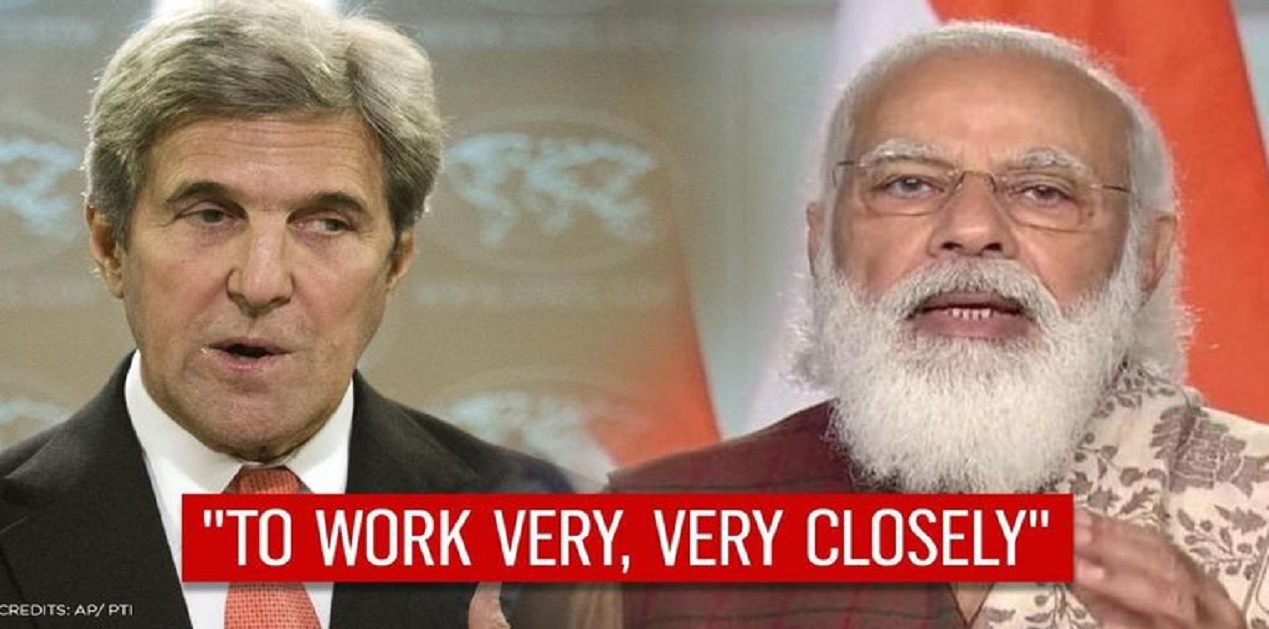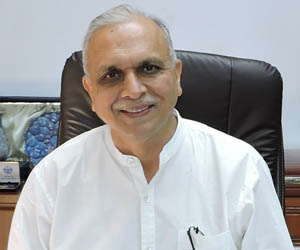Coinciding with Earth Day, President Biden will be hosting a summit of world leaders to discuss climate change on 22-23nd April 2021. The purpose of the summit is to persuade the leaders to undertake ambitious goals to cut the greenhouse emissions and keep the global temperature rise to within 1.5°C above the pre-industrial levels. Prime Minister Modi is expected to participate in the summit.
Climate change figures in Biden administration’s top four priorities. The US Presidential Special Envoy on Climate Change John Kerry has been travelling around the world, including Europe, India and China, drumming support for more ambitious climate action aimed at reducing CO2 emissions.
For its climate action campaign to carry moral weight, the US must lead by example and reduce its own emissions. The world’s top emitters of CO2 in 2019 were China (30.34%), the USA (13.43%), EU 27+UK (8.69%), India (6.83%), Russia (4.71%), and Japan (3.03%).1President Trump was dead against climate change and regarded it as a hoax. The US is the largest producer of oil in the world (about 11 million barrels per day in 2021). The multibillion oil lobby in the US is against US activism on climate change.
Sadly, the developed countries who preach to others, have themselves failed to meet the modest goals of the 2015 Paris Climate Change agreement. Recent research shows that since then the CO2 emissions have gone up rather than come down. The Paris goal of keeping the mean global temperature below 2degrees celsius cannot be realized if the present rate of emissions continues. If no mitigation action is taken now, the mean global temperature will increase by 3.7 degrees Celsius by the end of the century.
At the forthcoming Climate Change Summit, Biden will try to persuade nations to become carbon neutral as soon as possible. Some countries have announced 2050 as net-zero emissions date. China has promised to become carbon neutral by 2060. The US has yet to declare its carbon neutrality date.
The West frames climate change discourse in the context of rising temperatures, adverse consequences of climate change and the need for drastic emissions cuts. In this overarching narrative, the issues of historical responsibility, common but differentiated responsibility, climate justice et cetera have been overlooked. India is probably the only country that still talks of climate equity.
These issues were prominent in climate change discussions in the 90s. The Kyoto Protocol (1997) to UN Framework Convention on Climate Change (UNFCC) had assigned CO2 emission reduction quotas for the developed world. Developing countries were permitted to increase their emissions up to a certain point. The Kyoto Protocol was considered too ambitious and almost all developed countries jettisoned it. Paris Agreement, modest by comparison to the Kyoto Protocol, is not being fulfilled.
Pressure is building upon India to declare a date by which it would become net-zero emitter or carbon neutral. The government of India has resisted doing so considering that its development agenda is still unfinished. India has a long way to go to remove poverty and become even a middle income country. On the other hand, China, in the last 40 years, has emerged as the world’s second-largest economy and is aiming to overtake the US in the next few years. Only after achieving high economic growth, China declared the emission peaking year to be 2030 and carbon neutrality date of 2060. Such a declaration is meaningless unless directed by solid action now. Indian economy is 1/5th of China’s. An artificial date for carbon neutrality will not be in India’s interest.
India’s Climate Actions
Conscious of its responsibility, India is one of the few countries which has set for itself ambitious goals to enhance the share of renewable energy in its overall energy mix, reduce carbon intensity, and increase the efficiency of the economy.
India’s climate action programme is centred around some flagship schemes and programmes like the National Action Plan on Climate Change (NAPCC), National Adaptation Fund on Climate Change (NAFCC), Climate Change Action Programme (CCAP) and State Action Plan on Climate Change (SAPCC).2The National Solar Mission is at the heart of India’s renewable energy programme. To minimise the impact of climate change, India plans to generate 175 GW of renewable energy by 2022, implement an ambitious smart cities programme, start electric vehicles manufacturing, accelerate energy efficiency initiatives.
India has set the target of achieving 40 percent cumulative electric power installed capacity from non-fossil fuel-based energy resources by 2030. This will require installing total renewable energy (RE) capacity of 175 GW by 31 December 2022 i.e. 100 GW from solar power, 60 GW from wind power, 10 GW from biomass power, and 5 GW from small hydropower.3 As of February 2021, India has an installed capacity of about 38 GW of solar energy and an equal amount of wind energy. The share of renewable in India’s overall energy mix is steadily increasing. India has set a target of 450 GW of renewable energy by 2030. The government has also announced an ambitious program of manufacturing electric vehicles in the country. It has also taken steps to start working on the hydrogen economy.
Even so, the role of fossil fuel in India’s energy mix cannot be reduced overnight. According to estimates, fossil fuels i.e. oil, coal and gas makeup 75 per cent of the Indian energy mix, which incidentally, is below the G-20 average of 82 per cent.4 In 2018-19, India consumed over 966 million metric tonnes of coal, importing nearly 227 million metric tonnes (2019-20). While the transition to clean energy is necessary, a sudden switch to cleaner energy is not easy. It will require the introduction of clean energy technologies in the manufacturing, transport, agriculture and housing sectors.
Further, the record of developed countries who are preaching to the others to undertake ambitious mitigation targets is dismal. It must also be borne in mind that the thrust to clean energy will only increase the dependence of developing countries on the developed countries who are investing in these technologies. In the end, it is the developed countries who would gain by the transition to clean energy.
The developed world which should fund the developing countries transition to clean energy has been found wanting in fulfilling its side of the bargain. Therefore, their insistence on carbon neutrality targets rings hollow. The Paris Agreement had envisaged the creation of a USD 100 billion fund annually to developing countries for transition to clean energy. Likewise, a green climate fund was also created. But little money has been disbursed.
After the climate summit, the 26th meeting of the Conference of Parties (COP) of the UNFCC will be held in Glasgow in November 2021. Even six years after the Paris agreement, many countries have failed to bring to the table nationally determined emissions reduction targets. Emissions have been increasing. Parties had agreed in Poland in 2018 to declare every two years their emissions targets. But the new regime would come in force only from 2024. This shows that there is no urgency in the international community to do something worthwhile to reduce emissions. COP 26 will be a good opportunity to review the implementation of the Paris climate change agreement.
Forcing developing countries to undertake ambitious mitigation targets is akin to playing with the lives and livelihoods of millions of poor people. Unfortunately, the developed world refuses to change its mindsets and make the lifestyles of its citizens more sustainable. This dichotomy between the developed and developing countries will remain.
The past trends show that India may have to fight this battle alone. India has also changed tactics. By promoting the International Solar Alliance (ISA) and Coalition for Disaster Resilient Infrastructure (CDRI), India has sought to rally the developing as well as the developed world around climate change action.
During his visit to India, John Kerry met PM Modi and other senior leaders to discuss climate action. From the public comments that he made, it seems that he was supportive of the actions India has taken and promised that the US will support India’s actions in mitigating CO2 emissions.
Interestingly, one ruling party (BJP) members brought about a private member’s bill in the parliament recently asking to declare 2050 as the date for carbon neutrality. Such a target will put unnecessary pressure on India. India is doing a lot to reduce emissions and there is scope for doing more.
India should gear up for enhanced pressure on it for doing more on CO2 mitigation. Without necessarily declaring a carbon neutrality date, it should nevertheless invest in the development of clean energy technologies, efficiency, renewable energy, afforestation, carbon pricing et cetera. It would also partner with other countries to promote climate action. This is necessary so that we do not become dependent on other countries for these technologies. This will also in line with the government’s Atmanirbhar program.
Given its climate actions in the last few years, India is in a good position to set the climate change agenda. Its record is far superior to that of the developed countries. Its per capita emissions are a fraction of those in the developed world. India would be one of the few nations helping to keep target of rise within 1.5 degrees celesius alive if it puts in place and operates 450 gigawatts of renewable power by the end of the decade.
In the forthcoming climate summit, India should actively promote the cause of climate change but should not give in to the pressure from the developed world to declare an artificial date for carbon neutrality.
Endnotes
- Crippa, M. et al. 2020. “Fossil CO2 emissions of all world countries – 2020 Report”. EUR 30358 EN. Publications Office of the European Union. Luxembourg. ISBN 978-92-76-21515-8. Thanks are to PK Hongzo, VIF, for providing this statistics.
- https://pib.gov.in/Pressreleaseshare.aspx?PRID=1564033
- Statistics compiled by PK Hongzo, VIF.
- https://energy.economictimes.indiatimes.com/news/power/infographic-indias-energy-mix-2019/72277786
(The paper is the author’s individual scholastic articulation. The author certifies that the article/paper is original in content, unpublished and it has not been submitted for publication/web upload elsewhere, and that the facts and figures quoted are duly referenced, as needed, and are believed to be correct). (The paper does not necessarily represent the organisational stance... More >>
Image Source: https://img.republicworld.com/republic-prod/stories/promolarge/xxhdpi/9yyhkuduxep2kd57_1613185863.jpeg?tr=w-758,h-433











Post new comment